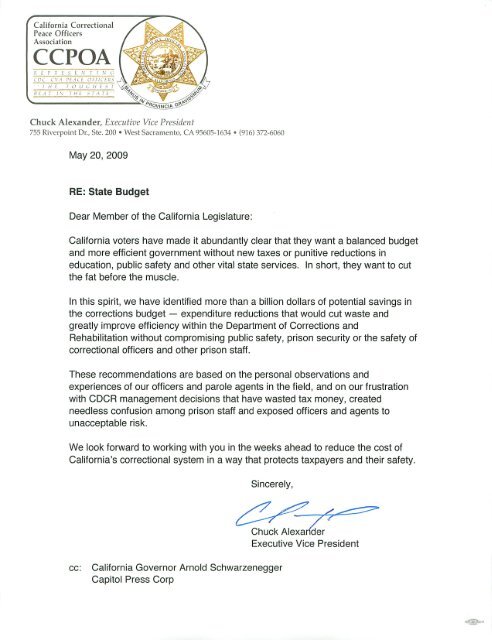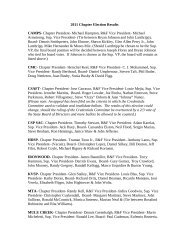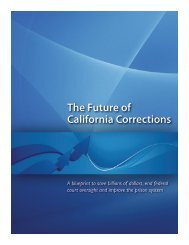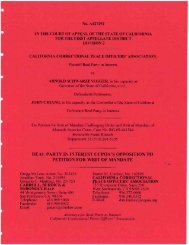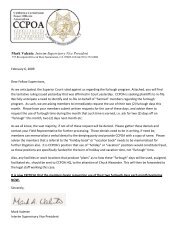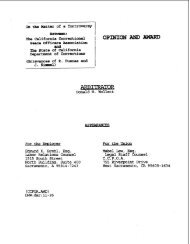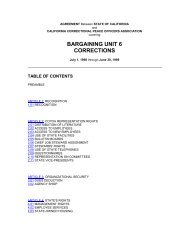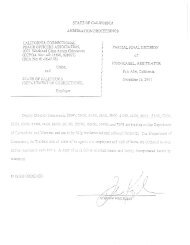Cut the Fat, Not the Muscle - California Correctional Peace Officers ...
Cut the Fat, Not the Muscle - California Correctional Peace Officers ...
Cut the Fat, Not the Muscle - California Correctional Peace Officers ...
You also want an ePaper? Increase the reach of your titles
YUMPU automatically turns print PDFs into web optimized ePapers that Google loves.
R E F O R M I N G C O R R E C T I O N S<br />
<strong>Cut</strong> <strong>the</strong> fat, not <strong>the</strong> muscle.<br />
While <strong>California</strong>’s inmate population has grown by less<br />
than six percent since 2002, <strong>the</strong> Department of Corrections’<br />
administrative bureaucracy has doubled. Billions of<br />
dollars could be saved by streamlining operations, reducing<br />
bureaucratic staff and eliminating waste and inefficiency<br />
— without jeopardizing public safety or increasing <strong>the</strong><br />
dangers for prison officers and parole agents.<br />
Specifically, we propose:<br />
• Save nearly $1 billion by capping <strong>the</strong> cost of inmate<br />
health care at a level equal to <strong>the</strong> per-patient cost of<br />
MediCal coverage. Currently, <strong>California</strong> is spending<br />
nearly twice <strong>the</strong> national average providing health care<br />
for its prison inmates, which is significantly higher<br />
than <strong>the</strong> cost of care being provided MediCal patients<br />
outside <strong>the</strong> prison system. Using <strong>the</strong> standard of care<br />
and cost established by MediCal would provide significant<br />
savings for taxpayers while ensuring adequate<br />
care for inmates.<br />
• Save up to $500 million by trimming CDCR administrative<br />
staff, which has ballooned by 400 new positions<br />
in recent months and more than doubled two<br />
of <strong>the</strong> department’s administrative divisions. Since<br />
many of <strong>the</strong>se positions are focused on planning for <strong>the</strong><br />
construction of prison facilities that will not be built<br />
in <strong>the</strong> foreseeable future, <strong>the</strong>y could easily be reduced<br />
without jeopardizing prison safety or operations.<br />
• Save $580,000 by directing <strong>the</strong> CDCR to end its lease<br />
for office space in San Diego, which has sat vacant for<br />
four years, and conduct a department wide audit to<br />
identify o<strong>the</strong>r unused or under-utilized lease spaces.<br />
To taxpayers, <strong>the</strong>se empty offices are a symbol of government<br />
waste at its very worst. Taking action would send<br />
a powerful message to taxpayers that <strong>the</strong> Legislature is<br />
serious about protecting <strong>the</strong>ir money.<br />
• Save $5 billion by postponing <strong>the</strong> AB 900 prison<br />
construction and parole programs not currently<br />
in place. Given <strong>the</strong> state’s budget shortfall and <strong>the</strong><br />
precipitous decline in state revenues, delaying <strong>the</strong>se<br />
projects would be prudent.<br />
• Save at least $50 million by discontinuing furlough<br />
days in state prisons and o<strong>the</strong>r state jobs requiring<br />
24/7 staffing. Doing so would eliminate <strong>the</strong> need<br />
to pay overtime to <strong>the</strong> remaining officers, who are<br />
required to cover for <strong>the</strong> furloughed officers. Paying<br />
overtime is significantly more costly to taxpayers than<br />
filling vacant officer positions.<br />
• Save up to $30 million by filling <strong>the</strong> 500 to 1,000<br />
correctional officer positions that remain vacant.<br />
Currently, existing officers are being forced to work<br />
overtime to cover <strong>the</strong>se positions, which is far more<br />
costly than hiring additional officers.
• Save potentially hundreds of millions of dollars<br />
($20,000 per parolee) by embracing our past recommendation<br />
to expand Drug Court, Mental Health<br />
Court, Reentry Court and Revocation Court. Doing<br />
so would dramatically reduce costly parole revocations<br />
that send inmates back to prison. Without<br />
adequate pre-release preparation and post-release<br />
support, <strong>California</strong>’s recidivism rate will remain <strong>the</strong><br />
nation’s highest.<br />
• Save $3.2 million by cancelling <strong>the</strong> Paroles Division’s<br />
current contract with <strong>the</strong> Employment Development<br />
Department, which has failed in its mission to help<br />
paroled inmates find jobs.<br />
• Conduct annual performance audits to determine<br />
which parole and rehabilitation programs are achieving<br />
<strong>the</strong>ir goals. Those that are working could <strong>the</strong>n be expanded,<br />
while ineffective programs could be eliminated.<br />
Currently, this is an area of tremendous waste.<br />
These are just some of our recommendations for reducing <strong>the</strong><br />
cost and improving <strong>the</strong> efficiency of <strong>California</strong>’s correctional<br />
system. We look forward to working with you to find o<strong>the</strong>rs<br />
that will help <strong>the</strong> department succeed in its fundamental<br />
mission — protecting <strong>the</strong> people of <strong>California</strong>.<br />
• Save millions by no longer providing CDCR managers<br />
and headquarters staff with state vehicles and mileage<br />
allowances for commuting to work. Cars and mileage<br />
allowances are currently being provided to about 1,000<br />
department personnel.<br />
<strong>California</strong> <strong>Correctional</strong> <strong>Peace</strong> <strong>Officers</strong> Association<br />
755 Riverpoint Drive • West Sacramento, <strong>California</strong> 95605


